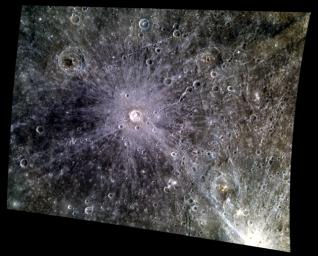
|
Stunning Light and Looming Darkness
- Click the image above for a larger view
- Full-Res JPEG (1436 x 1155) (271.1 kB)
- Full-Res TIFF (1436 x 1155) (5.0 MB)
Caption:
This color image shows Raden Saleh crater in a new light. The crater's bright ejecta rays are superimposed on the surrounding terrain, including a patch of dark low reflectance material (LRM) . In the lower right corner, rays from Qi Baishi crater are also visible.
This image was acquired as a targeted high-resolution 11-color image set. Acquiring 11-color targets is a new campaign that began in March 2013 and that utilizes all of the WAC's 11 narrow-band color filters. Because of the large data volume involved, only features of special scientific interest are targeted for imaging in all 11 colors.
Date acquired:
May 08, 2013
Image Mission Elapsed Time (MET):
10356510, 10356502, 10356498
Image ID:
4029993, 4029991, 4029990
Instrument:
Wide Angle Camera (WAC) of the Mercury Dual Imaging System (MDIS)
WAC filters:
9, 7, 6 (996, 748, 433 nanometers) in red, green, and blue
Center Latitude:
2.04°
Center Longitude:
158.8° E
Resolution:
440 meters/pixel
Scale:
Raden Saleh crater is about 23 km (14 miles) in diameter
Incidence Angle:
21.5°
Emission Angle:
38.1°
Phase Angle:
59.6°
Background Info:
The MESSENGER spacecraft is the first ever to orbit the planet Mercury, and the spacecraft's seven scientific instruments and radio science investigation are unraveling the history and evolution of the Solar System's innermost planet. MESSENGER acquired over 150,000 images and extensive other data sets. MESSENGER is capable of continuing orbital operations until early 2015.
For information regarding the use of images, see the MESSENGER image use policy .
Cataloging Keywords:
| Name | Value | Additional Values |
|---|---|---|
| Target | Mercury | |
| System | ||
| Target Type | Planet | |
| Mission | MESSENGER | |
| Instrument Host | MESSENGER | |
| Host Type | Orbiter | |
| Instrument | Mercury Dual Imaging System (MDIS) | |
| Detector | Wide Angle Camera (WAC) | |
| Extra Keywords | Color, Crater, Radio | |
| Acquisition Date | ||
| Release Date | 2013-07-05 | |
| Date in Caption | 2013-05-08 | |
| Image Credit | NASA/Johns Hopkins University Applied Physics Laboratory/Carnegie Institution of Washington | |
| Source | photojournal.jpl.nasa.gov/catalog/PIA17374 | |
| Identifier | PIA17374 | |
